Friday, 28 November 2025
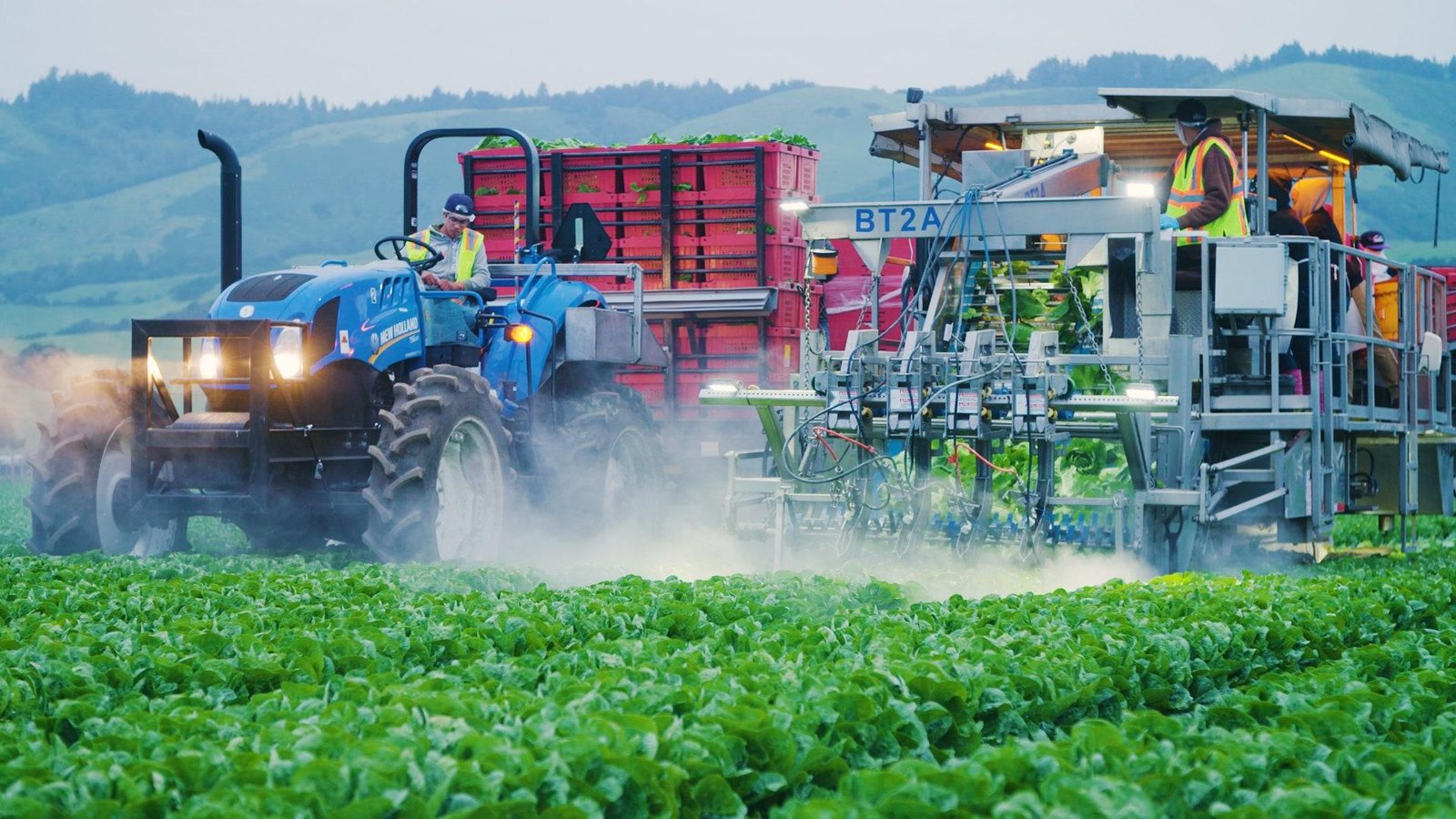
The GST rate revision for farm machinery and equipment is being viewed as a welcome move by the government to the farming community. The manufacturers have also hailed the move with prices coming down, which is expected to bring down the price. It will take some time before the benefits reach the farmers.
The recent cut announced by the Finance Ministry, Government of India, is being hailed by the farm mechanisation sector. With rate cuts from 12 per cent to 5 per cent for tractors with engine capacity of less than 1800 cc, the tractor and its allied sector are looking ahead for robust sales in the days to come, with farmers purchasing it in a more affordable way.
We see this as an opportunity to strengthen our partnerships with OEMs by delivering advanced, sustainable, and future-ready mobility solutions that support India’s agricultural growth, making it smarter, cleaner, and more efficient.
— Viveka Bhandari, COO, PVNA Group
In the category of farm machinery for market size, the focus subcategory are tractors, as it is the majorly sold farm machinery. According to the Federation of Automobile Dealers Associations (FADA) estimates, the retail tractor sales in FY 2024–25 were ~883,095 units. This year (FY 2025–26) outlook monthly retail data through mid-2025 show strong momentum (e.g., August 2025 retail tractor sales jumped to ~85,215 units and some OEMs reported record months in September).
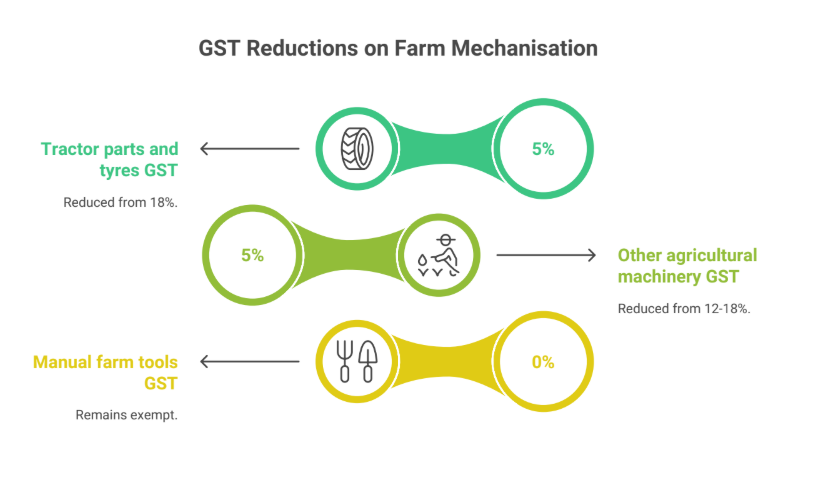
Post GST cut effective on September 22, a realistic near-term scenario predicts as follows: If higher monthly growth (post-GST) continues, FY25-26 tractor sales could recover above FY24-25 levels and possibly trend toward 9.0–10.0 lakh units (hypothetically), with upside if demand stays strong into the festive/post-harvest buying season. If demand reverts, growth will be muted.
Changes in offering
A 35 HP tractor will now be cheaper by Rs 41,000, followed by a 45 HP tractor being cheaper by Rs 45,000, a 50 HP tractor by Rs 53,000, and a 75 HP tractor being cheaper by Rs 63,000.
The revised structure on GST also mentions the following. Tractor tyres and parts have been lowered from 18 per cent to 5 per cent, while the tax rate on tractors has dropped from 12 per cent to 5 per cent. Most farm tractors, under 1800cc, soil preparation equipment like ploughs and harrows, and harvesting machinery such as threshers and balers come under the new GST regime.
These GST reforms will accelerate mechanisation by making tractors, harvesters, balers and implements more affordable, while lowering overall operating costs for farmers. This empowers industry players to address labour shortages, enhance farmer’s productivity, and promote sustainable practices.
— Narinder Mittal, President and Managing Director, CNH India
Key spare parts and components like tyres, tubes, hydraulic pumps, and gearboxes have also been moved from a high 18 per cent GST rate to 5 per cent.
Agri Ministry’s stand
Union Agriculture Minister Shivraj Singh Chouhan along with representatives from the Tractor and Mechanization Association (TMA), Agricultural Machinery Manufacturers Association (AMMA), All India Combine Manufacturers Association (AICMA and Power Tiller Association of India (PTAI), announced the rate cuts with much fanfare.
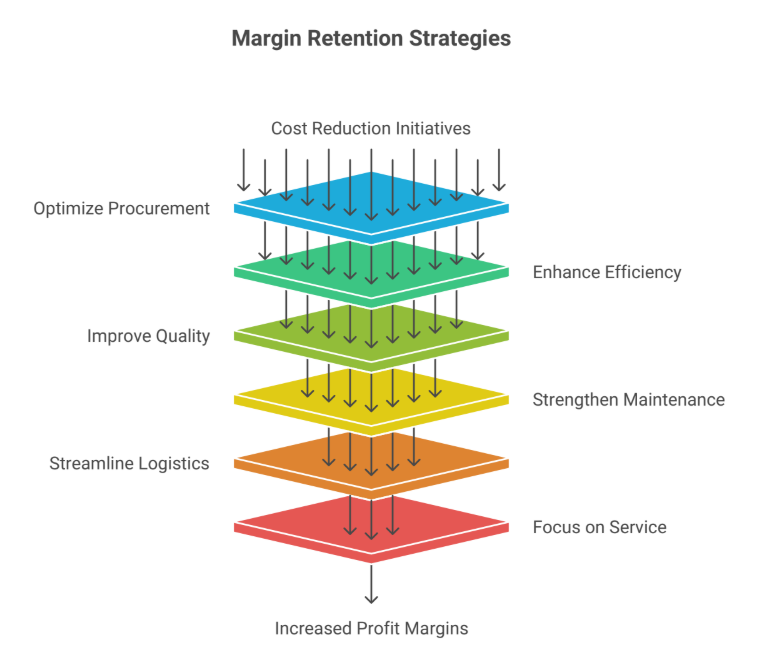
According to the minister, the government will widely disseminate information on the benefits through multiple communication channels to raise awareness among farmers. Chouhan emphasised that custom hiring centres, which will now get machines at lower prices, must reduce rental rates to ensure affordability for farmers.
Chouhan invited suggestions from manufacturer associations while framing future plans and urged the representatives to minimise the role of middlemen and ensure farmers directly receive the benefits of GST reforms.
Impact on manufacturing companies
Tractor manufacturing companies have been urged by the Ministry of Agriculture to pass on the benefits directly to the farmers. Going ahead with more sales anticipated due to the lower price, there will be more demand for these machines in the long run. This will enhance the production of more farm machinery.
Manufacturers are likely to look for optimising sales, reducing production costs. This is expected to be done focusing more on local sourcing, improve the manufacturing process, add the latest technologies, real time monitoring of production, supply chain initiatives, manufacturing specialised machines etc.
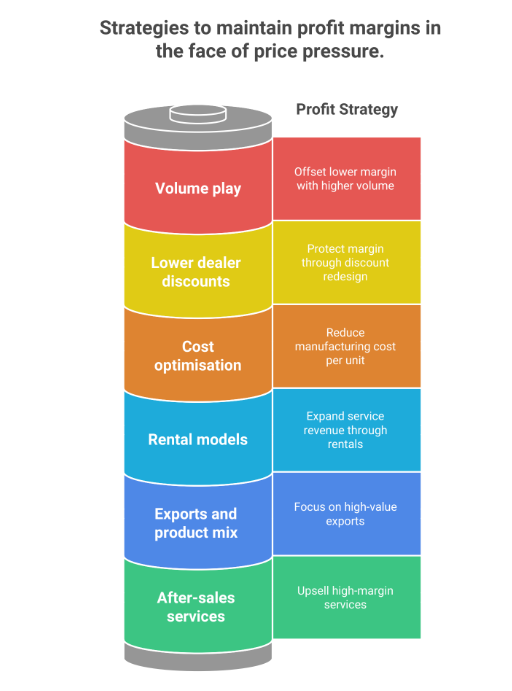
Viveka Bhandari, COO, PVNA Group, a Gurgaon-based auto components firm, mobility solutions provider, and caters to the tractor industry, says, “The GST reduction on tractors and farm machinery to 5 per cent is a historic reform that will make technology more affordable for farmers and accelerate mechanisation. At PVNA Group, we see this as an opportunity to strengthen our partnerships with OEMs by delivering advanced, sustainable, and future-ready mobility solutions that support India’s agricultural growth, making it smarter, cleaner, and more efficient.”
Narinder Mittal, President and Managing Director, CNH India, mentions, “We welcome the government’s decision to reduce GST on farm equipment, related components and tyres to 5 per cent. These GST reforms will accelerate mechanisation by making tractors, harvesters, balers and implements more affordable, while lowering overall operating costs for farmers. This empowers industry players to address labour shortages, enhance farmers’ productivity, and promote sustainable practices.”
Mahindra & Mahindra’s Farm Equipment Business (FEB), part of the Mahindra Group, has reported that its domestic tractor sales were at 64,946 units in September 2025, as against 43,201 units in September 2024, reflecting a 50 per cent year-on-year growth, on account of the benefit of GST reduction to customers and preponement of Navratri to September this year compared to last year’s festive period.
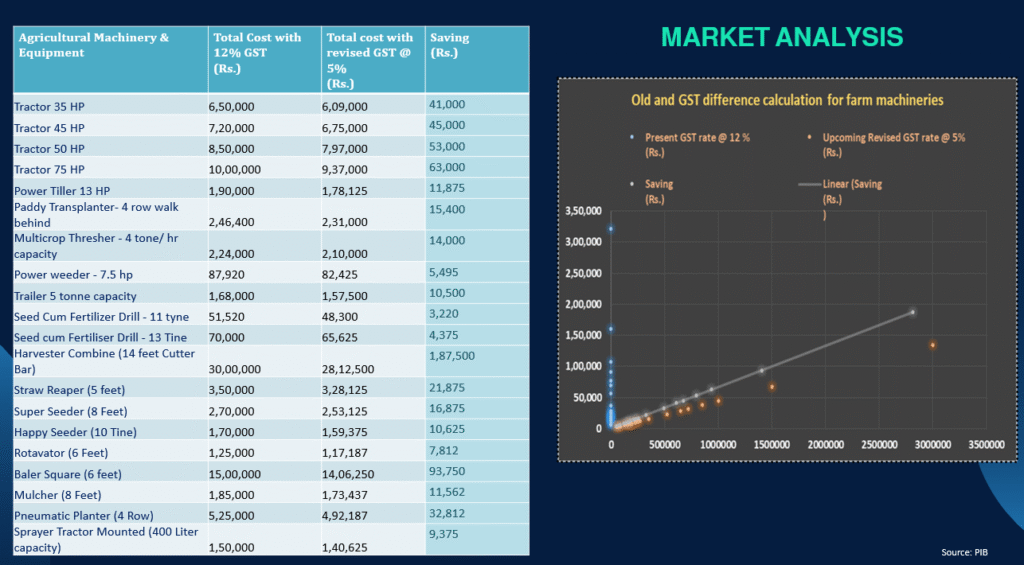
Total tractor sales (Domestic + Exports) during September 2025 were at 66,111 units, as against 44,256 units for the same period last year. Exports for the month stood at 1,165 units.
Veejay Nakra, President – Farm Equipment Business, Mahindra & Mahindra, while welcoming the move, said, “We have sold 64,946 tractors in the domestic market during September, a growth of 50 per cent over last year. The decision on the GST rate cut, has increased offtake in the first nine days of Navratri, which is in the month of September this year, compared to October last year. This has been further supported by factors like a positive Kharif outlook, an increase in the area sown this season and an above-normal monsoon.”
The decision on the GST rate cut, has increased offtake in the first nine days of Navratri which is in the month of September this year compared to October last year.
— Veejay Nakra, President – Farm Equipment Business, Mahindra & Mahindra
Sonalika Tractors clocked its highest-ever monthly overall sales of 20,786 tractors in September 2025. The recent GST reduction on tractors has further strengthened farmer confidence and made heavy-duty tractors more affordable and accessible nationwide.
Says Raman Mittal, Joint MD, International Tractors (Sonalika and Solis), “We have proudly clocked our highest ever monthly sales. This milestone belongs to the spirit of India’s farmers, whose dreams inspire us to turn our ambitions into achievements. The extended monsoon season and the recent GST reduction announced by the central government has given a significant push in uplifting farmer sentiments and upgrading themselves by adopting new age technology tractors. We will continue to stand by the side of the farmer to ensure their progress through every harvest.”
Will farmers benefit, or middlemen usurp?
Both outcomes are possible; government push and market competition will determine the pass-through. Says Mukesh Ramagoni, Project Manager (ACRAT), Agri Innovation Hub (AgHub) of Professor Jayashankar Telangana Agricultural University, Rajendranagar, Hyderabad, “Dealers, distributors, or local middlemen can absorb some of the tax gain as higher margins unless there’s pressure/accountability to cut MRP. That’s a real risk in any tax cut. Lack of farmer awareness about what the final price should be can also blunt the effect.
The extended monsoon season and the recent GST reduction announced by the central government has given a significant push in uplifting farmer sentiments and upgrading themselves by adopting new age technology tractors.
— Raman Mittal, Joint MD, International Tractors
The ministry said it will monitor/drive awareness so the benefit reaches farmers. Officials have been vocal about preventing “absorption” by intermediaries. Competitive OEM market and visible MRP reductions will make it hard for all dealers to keep margins if competitors reduce prices; bigger manufacturers and large dealer networks typically pass on cuts to maintain volumes. Public awareness campaigns, SMS alerts, and quick online price lists from OEMs/authorised dealers can bring in a change.”
The outlook
With days to come, a clear picture will emerge on how the GST rate cut is actually benefiting the farmers. On whether middlemen will become the spoilsport and pocket the benefits.
Dealers, distributors or local middlemen can absorb some of the tax gain as higher margins unless there’s pressure/accountability to cut MRP. That’s a real risk in any tax cut. Lack of farmer awareness about what the final price should be can also blunt the effect.
— Mukesh Ramagoni, Project Manager (ACRAT), Agri Innovation Hub (AgHub) of Professor Jayashankar Telangana Agricultural University, Rajendranagar, Hyderabad
As Rohan Kanwar Gupta, Vice President & Sector Head, Corporate Ratings, ICRA mentions, “The recent GST rate cut has significantly lowered the tax on agricultural tractors and machinery in India. This move has led to a meaningful drop in prices of tractors and farm implements, improving affordability for farmers. The enhanced affordability is expected to drive near-term demand and potentially push industry volumes to record highs. Additionally, the price reduction may help cushion the impact of the anticipated cost increase due to the transition to TREM V emission norms from April 2026.”
The enhanced affordability is expected to drive near-term demand and potentially push industry volumes to record highs. Additionally, the price reduction may help cushion the impact of the anticipated cost increase due to the transition to TREM V emission norms from April 2026.
— Rohan Kanwar Gupta, Vice President & Sector Head, Corporate Ratings, ICRA
The already manufactured machines need to be disposed of, and whether the machine manufacturers will actually pass on the benefits also remains in question.
However, the overall scenario seems to be favouring the farmers as lower GST rates will directly reduce the overall price farmers pay for machinery like tractors, harvesters, and irrigation tools. This will help small and marginal farmers, sensitive to high capital costs, invest in modern equipment to improve productivity and efficiency.
— Sanjiv Das ( sanjiv.das@mmactiv.com )